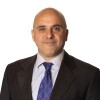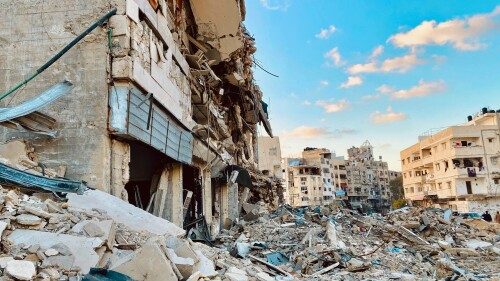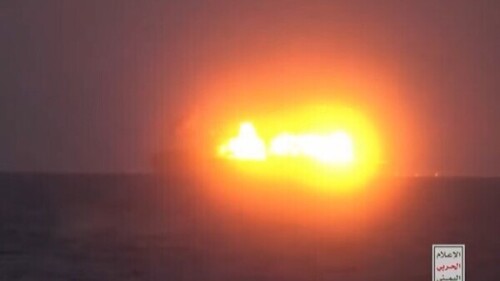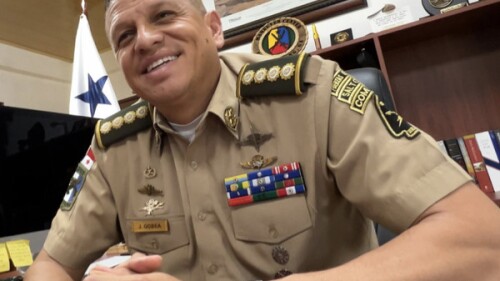Tensions were simmering in Jerusalem before the trouble began. |
You can feel these things coming, if you know how to listen to the city. A few days before the trouble began in Jerusalem, I noted a curious incident. Buying a schwarma in the Jerusalem seam line neighborhood where I live, I had remarked (in Hebrew) to the young Palestinian Arab man serving me that it must be difficult to maintain the Ramadan fast when one is working around food all day. It seemed to me to be a friendly remark, and I had anticipated a good humored response of some kind (the place is two minutes from my home. I go there regularly). Instead, the young man stared at me, a bewildered and hostile look on his face, the look of a person who has just been insulted without provocation. Concerned at a misunderstanding, I repeated the remark. His expression did not change. His colleague, seeing that something was beginning to go on, remarked “we get used to it.” I mentioned this tiny incident to a friend later that day. We agreed that the city was tenser than usual, and that something was in the air.
Jerusalem is a city with a built in tension at the best of times; “a pile of dynamite,” as a colleague of mine likes to refer to it. The levels rise and subside, depending on the season. The festival of Ramadan brings with it a heightened focus on Islamic religious and national matters for the city’s Arab Muslim population. One of the unfortunate by-products of this tends to be a rise in incidents of friction between that population and the Jewish part of the city. Perhaps the contradiction between the undoubted desire on the part of this population for a return to Islamic rule in Jerusalem, and the current reality of Israeli authority plays a part in this. A year of lockdowns and the resultant frustration are also no doubt contributing factors.
Jerusalem came as close as it has come in recent years to an explosion.
Over the last week, Jerusalem came as close as it has come in recent years to an explosion. Latterly, the trends have been largely in the other direction. During the Second Intifada of 2000-4, the Israeli Jewish and Palestinian Arab communities in the city became largely sealed off from one another. But in the subsequent years of relative quiet, hijab’ed young women in the malls of west Jerusalem, and Hebrew speaking Israelis in the restaurants and stores of the market in the Old City’s Muslim Quarter have become a familiar sight. The latest clashes will not be enough to shift that dynamic. That will come only if deaths occur, and if the city sees a new terror campaign. We are not there yet, and hopefully will not get there.
Two elements precipitated the current brushfire. The first relates to an unpleasant reality well known to Jewish and particularly Ultra Orthodox residents of the city. This has been absent from much of the coverage on these events, and needs to be stated plainly. For Jews in Jerusalem, this time of year brings with it a heightened possibility of physical assault. A minority of Arab Muslim young men in Jerusalem choose to express their supposed religious sentiments by random attacks on identifiable Jews. Ultra Orthodox Jews, who are unlikely to be armed or to have military training, tend to be the particular recipients of this practice.
Ultra Orthodox Jews, who are unlikely to be armed or have military training, are vulnerable to random attacks.
The practice is not new. But this year, a new twist was added. The attackers would film their assaults on random Jewish passers-by, and then upload the videos to the social media site TikTok. The style of the videos was ironic, amused, and coolly malicious, in the style favored by this medium. Somehow, this increased the sense in which the victims portrayed in them were dehumanized. Their appearance caused widespread anger. There followed a number of revenge attacks carried out by young Israelis on random Arabs employed in the service sector in downtown west Jerusalem.
A Palestinian protestor pushes away a barrier at the Damascus Gate in Jerusalem on April 25. (AFP) |
A second element contributing to the charged atmosphere was a decision by the Israeli authorities to fence off a section of the area around the Old City’s Damascus Gate. This is the main entrance to the Old City from the Arab neighborhoods adjoining it. During Ramadan, large crowds gather there in the evenings, after the daily breaking of the fast. The reason for the placing of barriers was an attempt to prevent crowding, because of concerns of the spread of Covid 19. But the barriers were seen by many Arab Jerusalemites as a breaking of the status quo and an unacceptable infringement on their right to assembly.
All these elements came together on the evening of Thursday, May 22nd. Lehava, a far right Jewish movement, organized a demonstration to defend what it called “Jewish dignity,” and in protest against the assaults on Jewish Jerusalemites. The plan was to march from the municipality building to the Damascus Gate. The latter area, meanwhile, was witnessing nightly angry demonstrations by young Palestinian Arabs to protest the placing of barriers. The scene was set for a confrontation.
Supporters of the Jewish far-right Lehava movement demonstrate near Jerusalem’s Old City. (AP) |
I attended both rallies, my journalists’ credentials enabling me to slip through the tight police lines separating them. The Lehava demonstration brought together an eclectic mix of various Jewish publics in the city. There were Ultra-Orthodox youths, in their black kippot (skull caps) and white shirts, many of them slight of build and quickly shifted by any sudden moves on the part of the police. There was a smattering of older, tough looking men with knitted kippot and long sideburns, representatives of the hardcore religious nationalist element among the West Bank settlers, a few of them carrying weapons. There were a number of young women, identifiable by their clothing as also hailing from the national religious public. Also some youths wearing the colors of the Betar Jerusalem football team. The core supporters of this team are known for their nationalist and anti-Arab sentiments.
It being Jerusalem, there were also a number of the city’s eccentrics and misfits, who added a surreal and oddly comic touch to the proceedings. A young man often seen wandering in the town center who wears a strange, self-designed military costume intended to invoke the World War I British officers’ uniform of Zionist leader Ze’ev Jabotinsky was present, in his full regalia. I saw him in intense conversation with a couple of Ultra-Orthodox youths. A woman in a clown costume was there, too, explaining to the bemused protestors that she had come to share positive energy. The chants were unambiguous, however, and had nothing comic about them. “Death to the Arabs” was the one most frequently heard.
At the Damascus Gate, the demonstrators were similarly overwhelmingly male and young. There was a smattering of older men identifiable by their dress as Salafi Muslims. The two crowds were a little out of earshot of each other. The scenes were rougher at the Damascus Gate. Stones and projectiles were thrown at the police and their vehicles. The police responded with force. Chants of “Allahu Akbar” and “With spirit and blood, we will redeem you, O Al Aqsa.” Stun grenades, “skunk” water, sponge tipped bullets were fired at one point. The smell of the stinking water hung in the air. Two fires were set, and their burning into the night, with the explosions of the stun grenades and the chants of the protestors in the background lent an eerie, macabre air to the proceedings. The security forces halted the Jewish march a hundred meters or so short of the Damascus Gate. A mixed force of police and Border Guards, in surprisingly small numbers, succeeded in holding the line. The two crowds of demonstrators did not connect.
Thursday was the day the tensions reached their height. There were sporadic clashes through the night. In the following days, the demonstrations at the Damascus Gate were smaller. Early this week, the authorities ordered the barriers to be removed. As of now, things have quietened again. But Ramadan is not yet over. and Jerusalem Day, a time of mobilization for religious nationalist Israeli Jews, is approaching. The prospects for further flareups are therefore real.
Jerusalem remains the absolute center point of the long dispute between Jews and Arab Muslims.
This series of events is a reminder that Jerusalem, and in particular its Old City, and in particular the Temple Mount/Haram al-Sharif, remain the absolute center point of the long dispute between Jews and Arab Muslims for sovereignty west of the Jordan River. We have grown used to seeing this conflict played out using the latest hi-tech gadgets. F-35s over the skies of Syria, spy games in Teheran, mysterious explosions on ships in the Red Sea and the Gulf of Aden. Clashing narratives smoothly articulated in international fora. The events of the last week are a reminder of the visceral, angry clinch at the heart of this dispute. The groups of young people narrowly held apart by the thin green line of the Israeli security forces on Thursday night are not representative of the totality, or the majority of sentiment in their respective communities, of course. But neither are they and their activities completely alien or marginal to the places from which they come. For now, things are quiet, and the crowds dispersed. The tension has not left the air.
Jonathan Spyer is a Ginsburg/Milstein Writing Fellow at the Middle East Forum and director of the Middle East Center for Reporting and Analysis.










